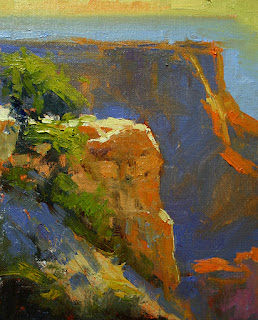
"Hidden Falls" 24" x 30" oil/linen, Stage 1, 5 minutes
A couple of weeks ago I expressed my desire to have my larger pieces look as fresh as my outdoor work...Walt Gonske comes to mind when I talk about large pieces that look like they are done plein air. If you have ever looked at one of Walt's paintings up close it is a train wreck of color and paint strokes. But when you walk back ten paces and look at the painting again it is a thing of beauty done by a master painter. I love my outdoor work. I like the way the paint goes on the canvas and I like the fresh look it has. Recently my studio work has suffered from having too much time to tinker with the painting. So I decided the way to handle this problem is to paint larger canvases with bigger brushes and with a kitchen timer ticking away the time to put myself on a time limit just like painting outdoors. I started my first painting today and decided to shoot photos of it in stages so I can show you the grand experiment whether I succeed or fail. We will do this together.
Up top is my initial drawing. This is going to be (I hope) a waterfall deep in a forest. It is actually a combination of three different waterfalls, all from Yosemite, put together in Photoshop to appear as one waterfall that I am projecting on a 42" TV off to the right of my easel. It will be dark at the top with the waterfall cascading into bright sunlight where I have a series of boulders going across the river then the painting disappears into shadows at the bottom.
The canvas was covered with cadmium orange that will show through the dark boulders and shadows. The drawing was put in with burnt sienna. Notice the directional arrows drawn in to remind me where I want the viewer's eye to travel. Time 5 minutes, brush size #12 flat.

"Hidden Falls" 24" x 30" oil/linen, Stage 2, Time 15 minutes
I start blocking in the boulders painting the darkest darks first and shaping the boulders so that no two are the same, some are cool and some are warm. Time 15 minutes, brush size #12 flat.
 "Hidden Falls" 24" x 30" oil/linen, Stage 3, Time 15 minutes
"Hidden Falls" 24" x 30" oil/linen, Stage 3, Time 15 minutes
My approach outdoors with a subject matter this complex would be to go to my center of interest and paint it first figuring if I fail at this point I can wipe off the painting and start over or move on to something else. So I decide to do the same thing here and go after the center row of boulders that will be basking in a warm light. I spend time here to render each boulder and then throw in some water just to get a feel for what it might look like against the boulders. Time: 15 minutes, Brush size # 10 flat.

"Hidden Falls" 24" x 30" oil/linen
Here's a close up of my brushwork on the boulders.
"Hidden Falls" 24" x 30" oil/linen, Stage 4, 5 minutes
Now its time to start pulling the painting together and I am feeling good about the center of interest so now I will start at the top and work my way to the bottom. Since the middle of the painting will be warmish in tone I paint the top with a mixture of ultramarine blue, mauve and alizarin keeping it cool and it will appear to be in shadow when finished. I have 40 minutes in the painting at this point and I'm energized to get it completed. My kitchen timer says I have and hour and half left. Stayed tuned....
















































